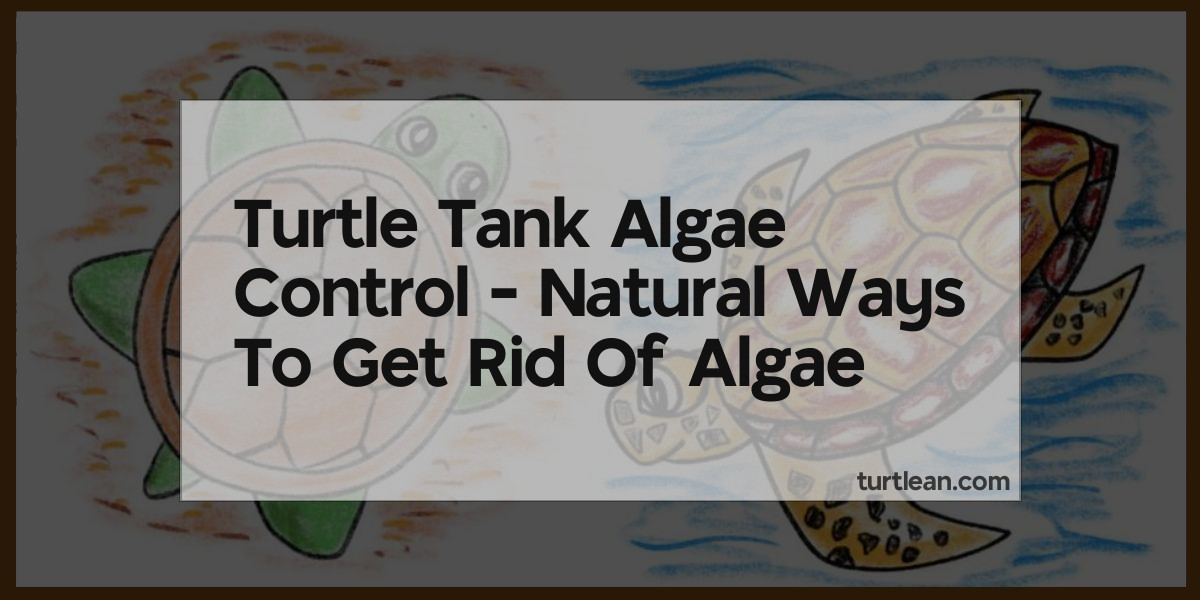If you have a turtle tank, you know that algae can be a problem. Algae can make your tank look dirty and can be harmful to your turtles. There are some natural ways to get rid of algae and keep your turtle tank clean and safe.
One way to control algae is to change the way you feed your turtles. Turtles are natural scavengers and will eat just about anything. This can include algae. If you feed your turtles a diet that includes some algae, they will help keep the algae population under control. You can also add some plants to your turtle tank. Plants will compete with algae for nutrients and can help keep algae growth under control.
Another way to control algae is to keep your turtle tank clean. This means cleaning the filter and doing a water change regularly. Algae love dirty water and will grow quickly in it. Keeping your turtle tank clean will help prevent algae growth.
If you have a problem with algae in your turtle tank, there are some natural ways to control it. Try changing the way you feed your turtles or adding some plants to the tank. Keeping the tank clean is also important. If you do these things, you can help keep your turtle tank algae-free.
What Are Some Natural Ways To Get Rid Of Algae In A Turtle Tank?

If you have a turtle at home, then you may have noticed some green algae growing in the tank. Algae is a common problem in turtle tanks, but it is easy to get rid of with some simple methods.
One of the best ways to get rid of algae is to vacuum it out of the tank. You can use a regular vacuum cleaner or a small aquarium vacuum. Be sure to vacuum the gravel and rocks in the tank to remove as much algae as possible.
Another way to get rid of algae is to use a algae eater. These fish are specifically designed to eat algae and will help to keep your turtle tank clean.
If you have a lot of algae in your turtle tank, you may need to do a partial water change. This means that you will need to remove some of the water from the tank and replace it with fresh water. This will help to get rid of any algae that is growing in the tank.
By following these simple steps, you can easily get rid of algae in your turtle tank and keep it looking clean and healthy.
How Can You Prevent Algae From Growing In A Turtle Tank?
If you’ve ever had a turtle as a pet, then you know that one of the most important things you can do to keep your turtle healthy is to maintain a clean and healthy environment. This means preventing algae from growing in their tank.
Algae can not only make your turtle’s home look dirty, but it can also be harmful to their health. When turtles ingest algae, it can cause health problems like shell rot, respiratory infections, and even death.
So,
How can you prevent algae from taking over your turtle’s tank?
Here are a few tips:
1. Keep the tank clean:
The first and most obvious step is to keep the tank clean. This means doing things like cleaning the filter and removing any debris from the bottom of the tank.
2. Change the water regularly:
In addition to keeping the tank clean, you need to change the water regularly. turtles are messy creatures and their waste can quickly turn into algae.
3. Use a UV light:
One of the best ways to prevent algae is to use a UV light. These lights help to kill algae and bacteria.
4. Add plants to the tank:
Plants are not only aesthetically pleasing, but they also help to keep algae in check. Plants compete with algae for nutrients, which can help to prevent algae from growing.
5. Use an algae eater:
If you’re struggling with algae, you may want to consider adding an algae eater to the tank. These creatures help to keep algae under control by eating it.
By following these tips, you can help to prevent algae from taking over your turtle’s tank.
What Are The Consequences Of Having Algae In A Turtle Tank?
If you have a turtle as a pet, then you may be wondering what the consequences are of having algae in their tank. Algae can be harmful to turtles if they consume it, as it can block their digestive system. Additionally, algae can also affect the water quality in the tank, making it more difficult for your turtle to breathe.
One of the best ways to prevent algae from growing in your turtle’s tank is to keep the tank clean. This means performing regular water changes and vacuuming the gravel. You should also avoid overfeeding your turtle, as excess food can contribute to algae growth.
If you do find that algae is starting to grow in your turtle’s tank, there are a few things you can do to remove it. One option is to use an algae eater, such as a snail or pleco. These creatures will help to keep the algae in check without harming your turtle. Another option is to manually remove the algae, which can be time-consuming but is effective.
No matter what method you use to remove algae from your turtle’s tank, it’s important to make sure that you do so regularly. Algae can quickly take over a turtle tank if left unchecked, so it’s important to be vigilant. By keeping your turtle’s tank clean and free of algae, you can help your pet stay healthy and happy.
How Do You Properly Clean An Algae-filled Turtle Tank?
How do you properly clean an algae-filled turtle tank?
If your turtle tank is anything like ours, then it’s probably starting to get a little bit green around the edges. Algae can be a pain to clean, but it’s important to make sure that your turtle has a clean and healthy environment to live in. Here’s a step-by-step guide to properly cleaning an algae-filled turtle tank:
1. Empty the tank of all water. This includes removing your turtle from the tank and placing it in a temporary holding container.
2. Scrub the entire inside of the tank with a bristled brush. Pay special attention to any areas that are especially covered in algae.
3. Rinse the tank out well with clean water.
4. refill the tank with clean water and add any necessary turtle-safe chemicals or treatments.
5. Place your turtle back in the tank and enjoy your clean and healthy environment!
Conclusion
There are many ways to get rid of algae in a turtle tank, but the most effective way is to use natural methods. Some of the best ways to control algae growth naturally are to use live plants, to increase the amount of aeration in the water, and to use a UV light to kill the algae.
If you’re looking for ways to control algae growth in your turtle tank, there are a few natural methods you can try.





Leave a Reply